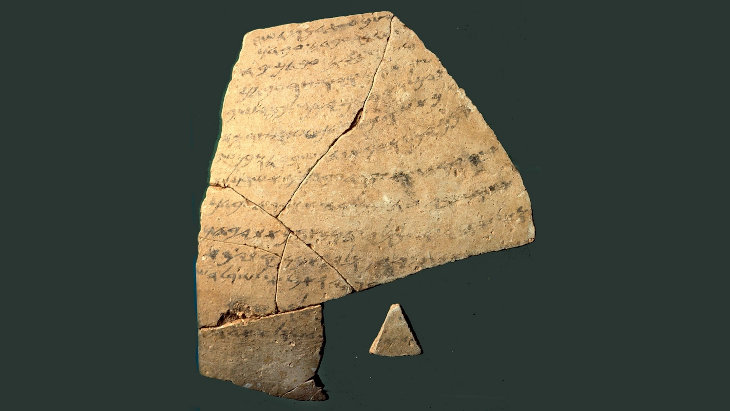 Passover’s Message of Hope in the Aftermath of Oct. 7
Passover’s Message of Hope in the Aftermath of Oct. 7


5 min read
This fascinating Hebrew letter from 630 BCE is the earliest documented example of how average Jews incorporated Judaism’s laws into their everyday lives.
Seven fragments of a Hebrew letter, written on broken pieces of discarded pottery, make up the inscription discovered by Hebrew University archaeologist Joseph Naveh (1928-2011) at Metsad Hashavyiahu in 1960. Carefully reconstructed, the entire trapezoid-shaped document measures no more than 20 by 17 centimeters, a little smaller than an iPhone, yet it records incredibly rare information: it is the earliest documented example of how average Jews incorporated Judaism’s laws into their everyday lives, found in an extra-Biblical text.
Ironically, it’s a complaint.
 Reconstruction of the Metsad Hashaviyahu Ostracon (GU-theolog, Public domain, via Wikimedia Commons)
Reconstruction of the Metsad Hashaviyahu Ostracon (GU-theolog, Public domain, via Wikimedia Commons)
More specifically, this 2600-year-old clay text, called an ostracon, records a common field laborer’s complaint against his abusive employer. It is the very first lawsuit brought by an ordinary Jew that invokes the authority of the Torah to support a claim.
The ostracon, which is also known as the Yavneh-Yam letter because it was discovered near the port of ancient Yavneh on the Mediterranean coast, was thoroughly analyzed by Professor Naveh. The fairly precise early paleo-Hebrew handwriting and other archaeological factors allowed him to date the ostracon to the late seventh century, probably to the reign of King Josiah, during the First Temple period. The grammatical infelicities in the text suggest that the professional writer transcribed the laborer’s account verbatim, mistakes and all, for submission to the local governor.
What exactly happened? We need to read between the lines to reconstruct the initial problem. It seems that the laborer was taking a well-deserved break in the field after finishing his pre-Shabbat quota of work. In the text, adapted from the translation by Anson F. Rainey (Posen Library of Jewish Culture and Civilization, Vol 1), the field hand refers to himself in the humble third-person “servant”:
May the lord, the governor, listen to the word of his servant! As for your servant, your servant was harvesting in Hatsar-asam. And your servant harvested and finished and stored it in the granary as always before the Sabbath.
Moments later, he was accosted by Hoshayahu ben Shobay, apparently a supervisor or foreman of some sort, who punished the unnamed servant for his presumed laziness by seizing his cloak and taking it as collateral for an unspecified length of time, or perhaps against a measure of harvesting to be done.
When your servant had measured his harvest and stored it in the granary as always, then Hoshayahu son of Shobay came and took your servant’s cloak. It was when I had completed my harvest as always, that he took your servant’s cloak!
The field laborer is filled with righteous indignation, insistent that he had already completed his quota of work, and that Hoshayahu – whose name, 26 centuries later, is now remembered as the first toxic boss in Jewish legal history mentioned in an extra-biblical Hebrew text – imposed a harsh and illegal punishment. Even though the field hand had already completed his work, and thus was entitled to a moment’s respite, the bad boss took the draconian step of seizing the worker’s cloak!

It should be borne in mind that in the 7th century BCE, poor laborers were likely to own only one change of clothes, with the cloak serving as both protection from the elements by day and a blanket by night. The laborer is prepared to back up his claim with witnesses:
And all of my fellows will testify in my favor, those who harvest with me in the heat of the sun…my fellows will confirm my testimony. I am innocent of guilt.
Return my cloak!
Since Professor Naveh made this remarkable discovery, many great scholars have dedicated energy to squeezing every possible scrap of meaning from the brief and fragmentary complaint. Perhaps the most profound observation is the laborer’s implicit understanding that the foreman’s disciplinary action went beyond the acceptable rules of conduct, as taught in the Torah itself.
Even though the field laborer may have been illiterate, he was apparently familiar with the strict guidelines to be followed when seizing a garment, described in Deuteronomy 24:10-13 and here in Exodus 22:25-27:
If you at all take thy neighbor's garment to pledge, you shall restore it unto him by that the sun goes down; for that is his only covering, it is his garment for his skin; wherein shall he sleep? and it shall come to pass, when he cries unto Me, that I will hear; for I am gracious.
It is ironic that the earliest evidence of application of Jewish law, outside the text of the Hebrew Bible, is a lawsuit against a toxic boss. But what it says about Jewish society during the First Temple period is fascinating – even a poor, illiterate field hand knew that the Torah dictated protections for his basic standard of living, and he was willing to assert his rights with the governor himself.
The phenomenon of Jewish chutzpah has ancient precedent.
